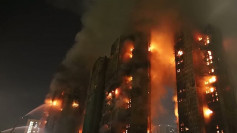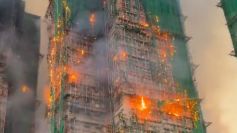Hong Kong's deadliest residential fire in decades burned through a second day on Thursday, leaving at least 44 people dead, nearly 300 unaccounted for and three construction executives in police custody as authorities investigate whether unsafe renovation materials fueled the catastrophe. The blaze tore through the Wang Fuk Court complex in Tai Po, a dense northern district near the mainland border, engulfing seven of eight towers sheathed in bamboo scaffolding and green construction mesh.
Thick smoke continued to pour from multiple towers Thursday morning as firefighters struggled to reach the upper floors, battling extreme heat, falling debris and obstructed stairwells. "Debris and scaffolding of the affected buildings (is) falling down," said Derek Armstrong Chan, deputy director of Fire Service operations. "The temperature inside the buildings concerned is very high. It's difficult for us to enter the building and go upstairs to conduct firefighting and rescue operations."
The devastation prompted a criminal probe after police discovered building materials that allegedly failed safety standards. Senior superintendent Eileen Chung said investigators had "reason to believe that those in charge of the construction company were grossly negligent," announcing the arrest of three men-two directors and an engineering consultant-on suspicion of manslaughter. Officials said Styrofoam, "highly flammable," had been found installed near elevator lobbies in one tower, with its purpose still unclear.
Authorities said the fire originated on external scaffolding of one tower before racing across bamboo supports and protective mesh-materials long used in Hong Kong construction but currently being phased out. Strong winds accelerated the spread. Video footage showed flames leaping from multiple 32-story blocks as burning debris cascaded to the ground.
At least one firefighter was among the 44 dead, and hospitals reported 62 injured residents suffering burns and smoke-related trauma. Hong Kong Chief Executive John Lee said 279 residents were still missing as of midnight and 900 people had taken shelter in temporary facilities. "The priority is to extinguish the fire and rescue the residents who are trapped," Lee said. "The second is to support the injured. The third is to support and recover. Then, we'll launch a thorough investigation."
Residents described harrowing attempts to escape. Lawrence Lee said he lost contact with his wife after urging her to flee their apartment. "Once she left the flat, the corridor and stairs were all filled with smoke and it was all dark," he said, explaining she had been forced to retreat inside. Another resident, a woman surnamed Chu, said of her missing friends, "We don't know what to do."
From Beijing, Chinese President Xi Jinping urged an "all-out effort" to contain the fire and minimize losses, according to CCTV. Officials said roads around Tai Po remained closed, 39 bus routes diverted and at least six schools shut for the day as smoke continued to drift across the district.
The scale of destruction has drawn comparisons to the 2017 Grenfell Tower disaster in London, where flammable cladding contributed to 72 deaths. In Hong Kong, bamboo scaffolding-used for generations-has been under increased scrutiny since the city announced in March that 50% of public construction projects must shift to metal frames. Worker-safety groups say at least three major bamboo-related fires had already occurred this year.
Public frustration mounted on social media, where residents accused contractors of cutting corners and regulators of failing to enforce safety rules. The Wang Fuk Court complex, built in the 1980s under a subsidized home-ownership program, has been undergoing HK$330 million in renovations, with each unit paying HK$160,000 to HK$180,000.






